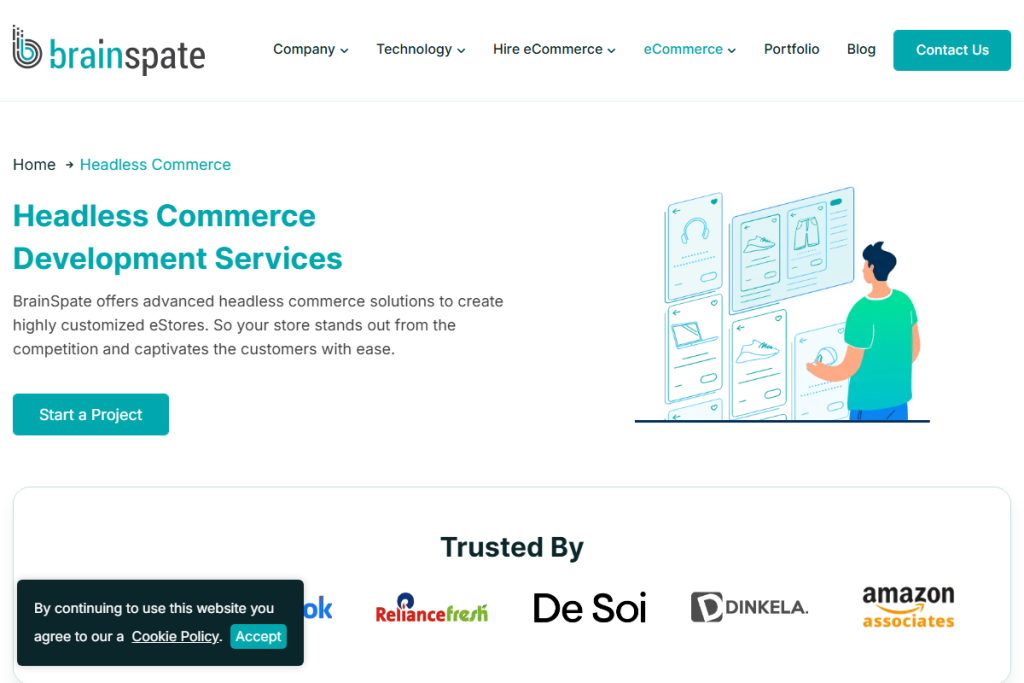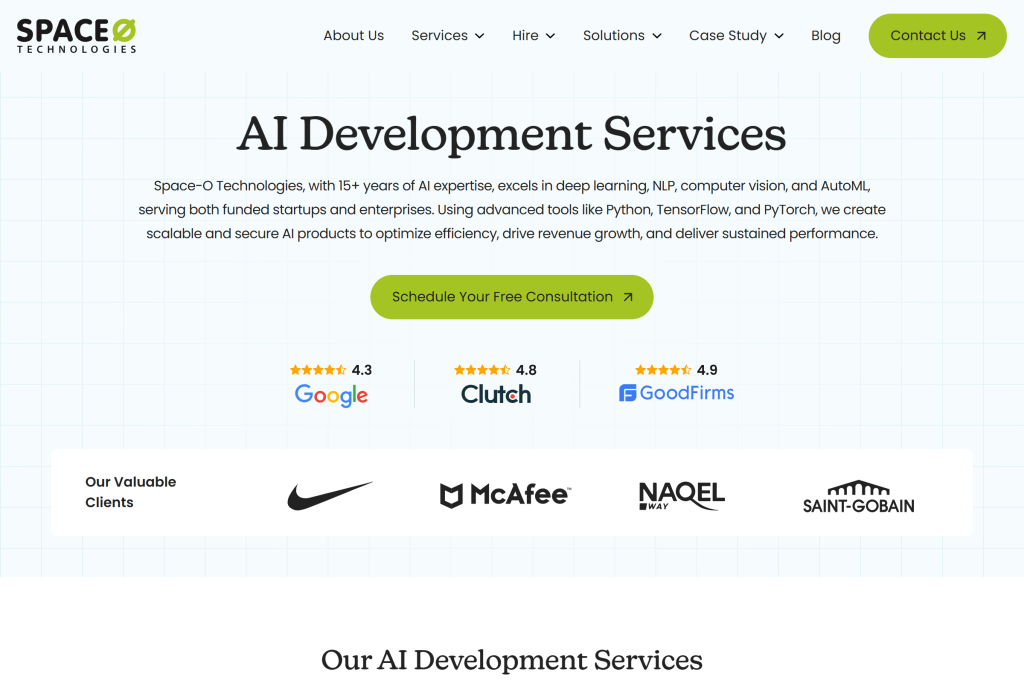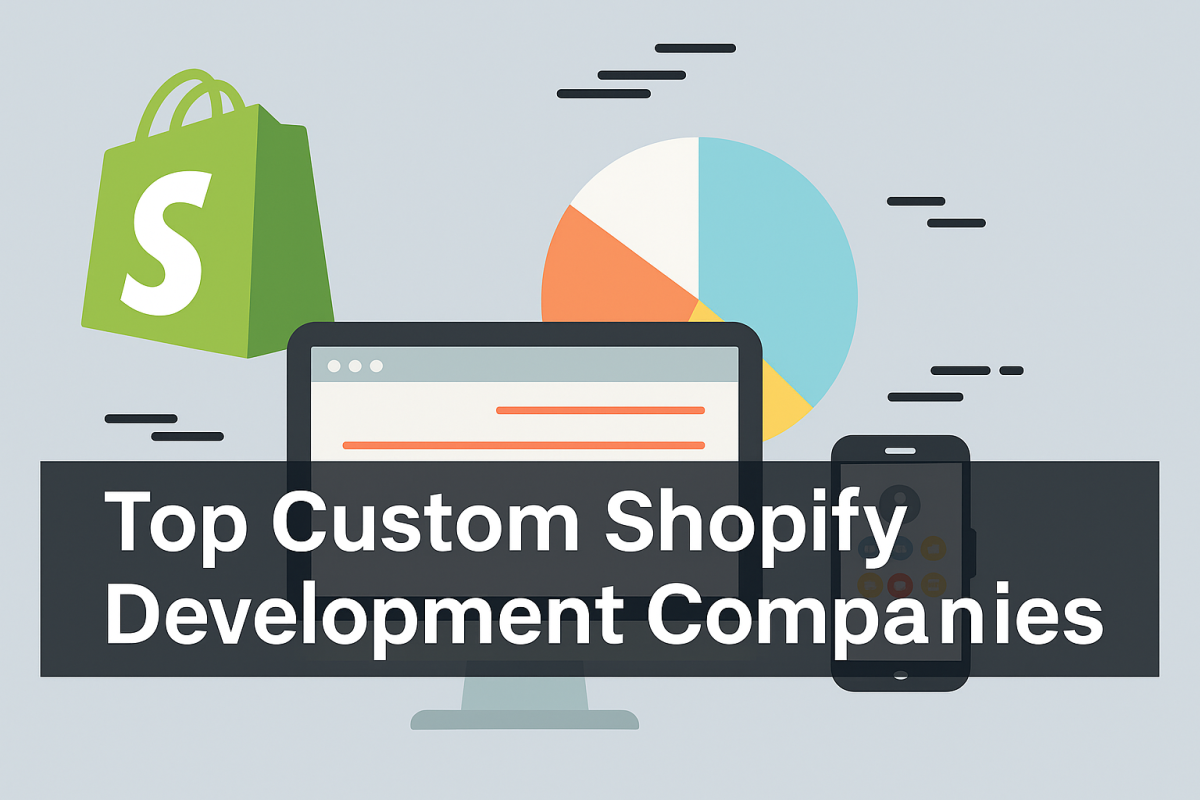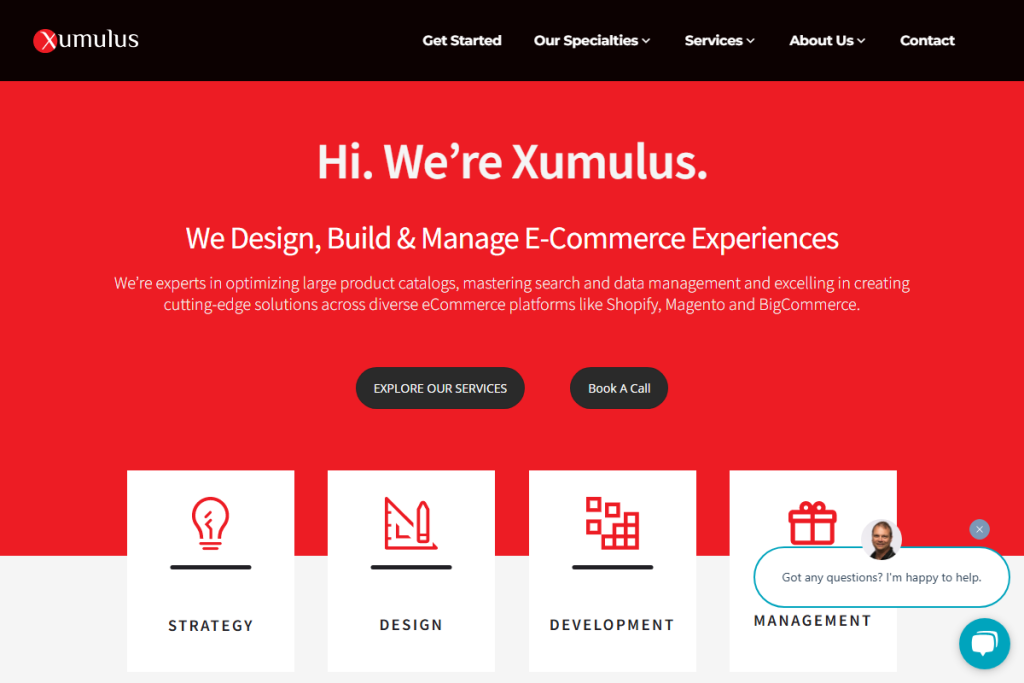Choosing the Right Headless eCommerce Development Partner: What We Looked For
The shift to headless architecture is no longer a trend—it’s quickly becoming the go-to approach for brands that want to deliver seamless, lightning-fast, and personalized shopping experiences. But here’s the thing: not all headless eCommerce development companies are created equal.
At TheSiteSlinger.com, we’ve worked with agencies and tech teams long enough to know what makes a great development partner. So when we set out to curate a list of the best headless eCommerce development companies, we didn’t just go with the flashiest portfolios or the most aggressive LinkedIn campaigns.
We dug deeper.
Why Headless? A Quick Recap
Before we get into how we selected the companies, let’s briefly explain what headless means—just to make sure we’re all on the same page.
In a headless eCommerce setup, your frontend (what customers see) is separated from the backend (where your business logic, data, and integrations live). This allows brands to:
- Launch faster and experiment more
- Integrate with modern tools and APIs
- Build custom user experiences across devices
- Future-proof their tech stack
It’s not for every business—but for the right one, it’s a game changer.
How We Selected These Companies
Here’s what we focused on when evaluating headless eCommerce developers:
Technical Expertise
We looked for teams fluent in modern frameworks like Next.js, Nuxt, React, Vue, as well as headless CMSs (Contentful, Sanity, Storyblok) and eCommerce backends like Shopify Hydrogen, BigCommerce, Magento (PWA Studio), Commerce Layer, Saleor, and more.
We prioritized companies with real production experience—actual stores running on these stacks, not just “we can do it” claims.
Strategic Thinking
Headless isn’t just about tech. It’s about solving specific problems:
- Sluggish performance
- Painful content updates
- Poor mobile UX
- Lack of omnichannel capabilities
The companies we chose understand this. They don’t just “build the frontend”—they plan for scalability, performance, and growth.
API-first Mindset
The best headless developers don’t get flustered by API docs. They’re comfortable connecting CRMs, search engines (Algolia, Elastic), inventory systems, personalization tools, and analytics platforms via API.
That’s the whole point of going headless: flexibility. And the dev team should be comfortable building with that in mind.
Results and Client Trust
We looked for clear signs of success:
- Case studies showing measurable improvements
- Long-term client relationships
- Transparent communication and agile workflows
We also paid attention to review platforms (like Clutch, GoodFirms) and organic signals (testimonials, client logos, real-world store URLs).
Bonus Points (That Still Matter)
Some qualities didn’t make or break inclusion—but they definitely made a company stand out:
- Design & UX chops – Clean, conversion-focused frontend work
- DevOps readiness – Strong hosting and CI/CD pipelines
- Accessibility & SEO awareness – Headless shouldn’t come at the cost of basic usability
- Post-launch support – Not just delivery and disappear
Why Trust This List?
We’re not just content writers. We’re a development team ourselves, working with agencies across the globe. We’ve built (and fixed) headless builds. We know what questions to ask and what red flags to spot.
This list isn’t sponsored. Nobody paid to be here. We chose these companies because their work speaks for itself—and because we’d consider partnering with them ourselves.
Ready to explore? Below are the headless eCommerce developers we believe deserve your serious consideration.
GetDevDone

Overview
GetDevDone is a white-label web development partner trusted by marketing agencies and digital brands for nearly two decades. With a global delivery model and U.S.-based project management, the company offers modular, scalable, and performance-focused eCommerce development services—including cutting-edge headless builds.
Headless Commerce Expertise
GetDevDone empowers businesses to transition from legacy or monolithic platforms to flexible headless architectures. Their developers build API-first storefronts with lightning-fast frontends that integrate seamlessly with Shopify Plus, BigCommerce, Adobe Commerce, and other headless-ready backends. The team is particularly skilled at delivering omnichannel experiences and personalized user journeys across devices and customer segments.
Key Services
- Headless Shopify and BigCommerce development
- Custom frontend engineering with React, Vue, and Next.js
- Storefront API and backend integration
- Migration from legacy platforms to headless stack
- Performance optimization, Core Web Vitals, and SEO support
- White-label partnerships with agencies for end-to-end delivery
Tech Stack & Tools
The GetDevDone team works with modern frameworks including React, Vue, and Angular, and often pairs these with backends like Shopify Hydrogen, BigCommerce APIs, or custom CMS solutions such as Storyblok and Sanity. Their delivery infrastructure includes CI/CD pipelines, QA processes, and flexible engagement models (dedicated teams or sprint-based projects).
Industries Served
They collaborate with digital agencies, startups, and retail brands across fashion, DTC, home goods, and B2B verticals—helping launch storefronts that are not only fast and reliable but also deeply tailored to business goals.
Why Choose GetDevDone?
For agencies and growing brands that need an experienced, behind-the-scenes development partner, GetDevDone delivers unmatched reliability, clean code, and scalable architecture. Their ability to handle complex headless builds with clarity and speed makes them a strong choice for ambitious eCommerce transformations.
Amitech Group

Overview
Amitech Group positions itself as a one-stop digital partner with a strong emphasis on innovation in eCommerce development. Based in Poland, the agency works with small to mid-sized businesses looking to integrate scalable, user-centric commerce platforms. They specialize in crafting future-proof digital ecosystems that are flexible, secure, and performance-optimized.
Headless Commerce Expertise
Their approach to headless eCommerce combines modern JavaScript frameworks with robust backend systems, ensuring lightning-fast performance and customizable user experiences. Whether it’s integrating APIs, decoupling frontend and backend, or building a modular architecture, Amitech ensures seamless functionality.
Key Services
- Headless architecture development
- UX/UI design tailored for conversion
- Cross-platform mobile solutions
- Systems integration and automation
- Advisory services for digital transformation
Tech Stack & Tools
Amitech frequently works with React, Vue.js, and Next.js on the frontend, alongside powerful backend solutions like Node.js, Strapi, and Shopify Hydrogen. Their headless builds often utilize APIs and microservices to allow for easier scaling and third-party integrations.
Industries Served
Their portfolio spans across eCommerce, retail, and financial services—with custom solutions built for performance and adaptability.
Client Feedback
“Their approach was not just about delivering what we asked for, but also challenging our assumptions to create something better.”
Why Choose Amitech Group?
With a perfect 5.0 Clutch rating and a team praised for timely delivery and strong communication, Amitech is a solid choice for businesses seeking strategic, high-impact headless eCommerce development.
BrainSpate

Overview
BrainSpate is an India-based digital agency that excels in delivering affordable, high-performing eCommerce platforms. Their lean pricing and rapid delivery make them an appealing partner for startups and SMEs looking to embrace headless commerce without sacrificing scalability or user experience.
Headless Commerce Expertise
BrainSpate focuses on decoupled systems that allow brands to innovate on the frontend while maintaining robust backend processes. They are especially skilled in building Jamstack-based architectures and API-driven storefronts optimized for speed, SEO, and user engagement.
Key Services
- Jamstack & API-first architecture
- Mobile-first frontend development
- UI/UX optimization for eCommerce flows
- Custom CMS integration
- Full-cycle headless commerce development
Tech Stack & Tools
They work with Gatsby, React, Vue, and Sanity CMS, often combining these with Shopify, BigCommerce, or custom backends to deliver fully customized headless storefronts.
Industries Served
From entertainment to online retail, BrainSpate has served a diverse clientele with high engagement eCommerce experiences.
Client Feedback
“Their ability to balance design needs and backend complexity was exceptional—great communication and a smooth workflow.”
Why Choose BrainSpate?
With a perfect 5.0 Clutch rating and standout reviews for project management and speed, BrainSpate offers budget-friendly yet highly capable headless eCommerce builds for ambitious digital businesses.
ClickySoft

Overview
Texas-based ClickySoft delivers fast, functional, and modern web applications for eCommerce businesses. Known for agility and cost-effectiveness, the team focuses on mid-market and small businesses seeking lean digital transformations through headless architecture.
Headless Commerce Expertise
ClickySoft emphasizes performance and scalability through headless builds, using a decoupled architecture to separate content management from front-end rendering. This allows businesses to push omnichannel content with minimal overhead and high flexibility.
Key Services
- Headless eCommerce store development
- Frontend frameworks like React and Vue.js
- Custom API development and integration
- CMS decoupling for better control
- Shopify and WooCommerce headless implementations
Tech Stack & Tools
ClickySoft’s headless builds are powered by React and Vue frontends, integrated with platforms such as WordPress (as headless CMS), Shopify, and custom Laravel or Node.js backends. They offer API integrations for payment gateways, CRMs, and ERP systems.
Industries Served
Their clients include both B2B and B2C brands, notably in consumer goods and retail.
Client Feedback
“ClickySoft met my deadlines, which were incredibly tight, without compromising the quality of the codebase.”
Why Choose ClickySoft?
With a strong 5.0 Clutch rating, ClickySoft is a reliable option for companies wanting to get their headless eCommerce projects off the ground quickly, especially those who prioritize cost control and delivery speed.
CSSChopper

Overview
CSSChopper is a seasoned development agency known for its front-end excellence and flexible backend integrations. Headquartered in India and working globally, the company has delivered more than a decade of development solutions, including many in the eCommerce space.
Headless Commerce Expertise
They offer headless development that pairs custom frontend interfaces with backend engines like Shopify Plus, Magento, and WooCommerce. Their solutions are built for high performance, seamless integrations, and tailored UI/UX.
Key Services
- Headless front-end development (React, Angular, Vue)
- Custom middleware/API layers
- CMS and eCommerce backend integrations
- Performance optimization
- Multi-store and internationalization support
Tech Stack & Tools
CSSChopper leverages Jamstack principles, often combining static site generators with content APIs, ensuring blazing-fast performance. Popular tools include Gatsby, Shopify Hydrogen, and Adobe Commerce Cloud integrations.
Industries Served
With deep experience in healthcare, eCommerce, and business services, CSSChopper offers cross-industry headless solutions adaptable to complex user journeys.
Client Feedback
“Their commitment to doing their best and positive attitude made them stand out from many other vendors we’ve worked with.”
Why Choose CSSChopper?
With over 60 reviews and a 4.9 Clutch rating, CSSChopper is praised for quality, communication, and the technical depth necessary for scalable, modular eCommerce ecosystems.
Krish TechnoLabs

Overview
Krish TechnoLabs is a premier digital commerce agency based in India, with a global clientele and a sharp focus on enterprise eCommerce. Their specialization in headless and composable commerce makes them a go-to partner for digitally ambitious brands.
Headless Commerce Expertise
Krish enables brands to go headless with confidence by designing scalable, component-driven architectures. They use API-first platforms and microservices to create personalized, high-speed commerce experiences across devices and channels.
Key Services
- Enterprise-grade headless architecture
- Progressive Web Apps (PWA) and SPA development
- Adobe Commerce and Shopify Plus integrations
- MACH (Microservices, API-first, Cloud-native, Headless) consulting
- Custom frontend development for omnichannel CX
Tech Stack & Tools
Krish TechnoLabs works with Adobe Commerce (Magento), Vue Storefront, React, GraphQL, and other modern headless tools to deliver modular commerce ecosystems. They support integrations with CRMs, CDPs, and DAMs to future-proof the digital stack.
Industries Served
Their client list spans global retailers, DTC brands, and B2B enterprises across fashion, lifestyle, and FMCG verticals.
Client Feedback
“Krish TechnoLabs has quickly understood our needs and implemented the solutions with precision and clarity.”
Why Choose Krish TechnoLabs?
With a 4.8 Clutch rating and 24 strong client reviews, Krish stands out for its enterprise readiness and deep alignment with modern eCommerce architecture principles like MACH and composable commerce.
The Digital Aditya

Overview
The Digital Aditya is a boutique development agency based in India, offering custom eCommerce builds with a clear emphasis on modern performance and user-centric design. With a tight-knit team and a focus on high-efficiency delivery, they are particularly appealing to startups and growth-phase companies exploring headless architecture.
Headless Commerce Expertise
Their headless offerings focus on speed, modularity, and front-end freedom. Using decoupled systems, they help clients build ultra-fast stores that integrate seamlessly with existing tools and services while enabling flexible content delivery across platforms.
Key Services
- Headless store development with API-first platforms
- UX/UI design for mobile-first commerce
- Custom backend integrations and middleware
- PWA and SPA implementations
- CMS decoupling with headless WordPress or Shopify
Tech Stack & Tools
The team uses popular stacks like React, Next.js, and Vue.js for frontend development and works with backends powered by Laravel, WooCommerce, or headless CMS solutions like Strapi and Contentful.
Industries Served
They’ve worked with clients across retail, personal care, and professional services, focusing on brands that want to stand out with lean, fast, and responsive online stores.
Client Feedback
“They’re responsive and fast, and they truly care about the impact of the project on your business goals.”
Why Choose The Digital Aditya?
Ideal for lean teams and founders looking for a cost-effective yet forward-looking tech partner, The Digital Aditya delivers thoughtful headless builds that keep performance and customer experience front and center.
DianApps

Overview
DianApps is a full-cycle digital product studio with global delivery capabilities. With a wide footprint in the USA, Australia, and India, they blend strategy and execution to help companies modernize and scale their digital commerce infrastructure.
Headless Commerce Expertise
DianApps brings composable commerce principles to life, crafting headless eCommerce experiences using microservices and API-first backends. Their team builds omnichannel solutions that perform well across platforms and adapt to evolving consumer expectations.
Key Services
- Composable and headless eCommerce builds
- Custom frontend development with React and Vue
- Backend architecture design
- Integration with CDPs, CRMs, and analytics systems
- Strategy and consulting for digital transformation
Tech Stack & Tools
They use React, Next.js, and Flutter on the front end, while backend choices range from Node.js and Laravel to Shopify Plus and Magento. They also integrate GraphQL and RESTful APIs to build interconnected, scalable ecosystems.
Industries Served
Clients range from healthcare startups to retail brands and logistics companies, all seeking flexible and future-proof eCommerce systems.
Client Feedback
“DianApps delivered ahead of schedule and made sure we were involved at every key decision point—rare in a vendor.”
Why Choose DianApps?
If you’re searching for a mature, globally active team with deep tech know-how and strategic insight, DianApps offers everything you need to launch, scale, or modernize your headless commerce project.
Tiny Frog Technologies

Overview
Based in San Diego, Tiny Frog Technologies is a design-first digital agency with a long-standing focus on WordPress and WooCommerce development. They bring a UX-centered philosophy into the headless eCommerce space, focusing on how structure and interaction shape online buying behavior.
Headless Commerce Expertise
Tiny Frog enables brands to move away from monolithic CMS structures by building API-connected eCommerce stores with React-based frontends. Their work emphasizes speed, flexibility, and content control through decoupled architecture.
Key Services
- WooCommerce + headless WordPress builds
- UX strategy and conversion optimization
- Custom integrations with third-party services
- Frontend frameworks for scalable UI
- Website security and hosting consulting
Tech Stack & Tools
They leverage React, Vue, and headless WordPress REST APIs for frontend freedom while using WooCommerce or custom PHP backends for store management. Content editing is made user-friendly despite the decoupled setup.
Industries Served
Tiny Frog works predominantly with service providers, nonprofits, and retail businesses looking for custom, conversion-friendly web solutions.
Client Feedback
“The design phase was incredibly collaborative—and the final product loads faster and converts better than our old site.”
Why Choose Tiny Frog Technologies?
Tiny Frog is a great fit for companies that value user experience and want to transition from traditional WordPress setups to modern, headless eCommerce without losing editing simplicity or design control.
Social Driver

Overview
Headquartered in Washington, D.C., Social Driver is a digital agency with a strong presence in social impact and advocacy sectors. While they’re widely known for strategy, branding, and UX, their development team delivers technically sound and visually engaging headless eCommerce solutions that align with organizational missions and customer experience goals.
Headless Commerce Expertise
Social Driver uses headless architecture to help nonprofits, education institutions, and public-facing organizations launch scalable, mission-driven commerce platforms. Their solutions allow content teams to retain editorial control while unlocking greater front-end customization and speed.
Key Services
- Headless WordPress and WooCommerce implementations
- Custom frontend development with React or Vue
- API-first integrations with donor platforms and CRMs
- Accessibility-first design and compliance
- Strategy for digital storytelling across channels
Tech Stack & Tools
Their development stack often includes React, Next.js, and headless WordPress via REST API or GraphQL. They also build Shopify-based headless storefronts tailored to campaign-oriented fundraising and product engagement.
Industries Served
Social Driver works primarily with government, nonprofit, healthcare, and education clients—often those with advocacy or eCommerce components integrated into larger digital strategies.
Client Feedback
“They took time to understand our values, and it showed in both the design and functionality of the site.”
Why Choose Social Driver?
If your brand seeks purpose-driven headless development with a focus on accessibility, storytelling, and digital engagement, Social Driver is a proven and values-aligned partner.
GrayCyan

Overview
GrayCyan is a boutique UI/UX and development agency that merges minimalist design sensibility with high-performance engineering. Based in India and serving global clients, they have a strong orientation toward building lean, conversion-optimized, and headless eCommerce solutions for startups and creative brands.
Headless Commerce Expertise
GrayCyan champions the headless model to create seamless user journeys that load fast and adapt well to different markets and device types. Their work is highly customizable, often involving CMS decoupling, design-first frontend frameworks, and integrations with cloud commerce engines.
Key Services
- Headless frontend development (React, Vue, Nuxt)
- Contentful, Prismic, and custom CMS headless builds
- Shopify and WooCommerce API integrations
- Conversion-optimized UX and interface strategy
- Ongoing support and performance analytics
Tech Stack & Tools
GrayCyan uses lightweight, modern stacks like Next.js with headless CMS platforms such as Sanity and Storyblok. Their focus is often on achieving high Lighthouse scores and smooth customer journeys across platforms.
Industries Served
They work with DTC brands, fashion startups, and lifestyle product companies aiming to elevate their online identity with custom headless storefronts.
Client Feedback
“Their UX instincts are sharp, and the final product was fast, on-brand, and easy for our team to maintain.”
Why Choose GrayCyan?
Design-led and technically skilled, GrayCyan is ideal for companies that value brand expression and performance equally—especially those looking to get to market quickly with a headless MVP.
Space-O Technologies

Overview
Space-O Technologies is a full-service software development firm with extensive experience in mobile apps, enterprise solutions, and eCommerce development. With offices in the US and India, they bring enterprise-grade capabilities to headless commerce builds across verticals.
Headless Commerce Expertise
Their approach to headless eCommerce includes end-to-end strategy, scalable architecture design, and seamless omnichannel delivery. Whether clients are looking to modernize an outdated CMS or launch a next-gen commerce experience from scratch, Space-O delivers robust, API-driven solutions.
Key Services
- Enterprise headless commerce platforms
- React/Vue frontend development
- Backend microservices and DevOps pipelines
- Magento, Shopify Plus, and BigCommerce integrations
- Global store rollout and localization
Tech Stack & Tools
Space-O uses a combination of React, Angular, and backend engines such as Laravel, Magento, or Node.js, often delivered through containerized cloud deployments and CI/CD pipelines. They’re also experienced with integrating AI-driven personalization tools into headless commerce flows.
Industries Served
They’ve worked across healthcare, logistics, education, and retail, serving both startups and enterprise clients with modular, scalable commerce solutions.
Client Feedback
“They built a complex, multi-region storefront that’s easy for us to scale—and that performs across devices and languages.”
Why Choose Space-O Technologies?
Space-O is a great fit for clients who need a technically deep partner to tackle complex backend architectures while delivering a fast, responsive headless frontend tailored to user behavior and business goals.
Wrapping Up: Choosing Your Headless eCommerce Development Partner
Headless commerce opens the door to speed, flexibility, and tailored customer experiences—but only when implemented with care and technical precision. The companies listed above each bring something unique to the table. Whether you’re building from scratch or transitioning from a legacy system, finding the right partner can mean the difference between smooth scaling and costly rework.
There’s no one-size-fits-all answer here. Some businesses need a lean, fast-moving dev team to get a store launched quickly. Others require long-term architecture planning, multi-service integrations, and global rollout support.
The important part is to choose a team that understands both the technical and strategic sides of headless development.
Need Help with Your eCommerce Project?
If you’re still evaluating options or need a second opinion, we can help.
- For agencies or startups looking to bring their headless storefronts to life quickly and cleanly, our own team at TheSiteSlinger.com offers white-label eCommerce development that’s fast, reliable, and easy to integrate with your existing workflows.
- For larger or more complex builds—custom logic, enterprise integrations, omnichannel experiences—we recommend our trusted engineering partners at GetDevDone. Their team handles high-scale, SLA-backed eCommerce systems with a focus on modular architecture and long-term growth.
No matter where you are in your headless journey, we’re always happy to talk. No pushy sales tactics—just straight answers and solid technical grounding.
Still not sure what you need? Reach out and tell us a bit about your project—we’ll point you in the right direction.


































